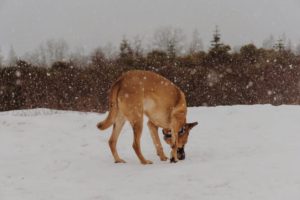It seems when it comes to dogs and snow, they either love it and can’t get enough, or hate it and want inside the second they are done pottying. I don’t know any dogs who aren’t quite sure how they feel about it.
We veterinarians, however, have discovered over the years that snow can be a useful diagnostic tool. Whether your dog loves or hates snow, it might help reveal problems you otherwise wouldn’t know were there.
No, there’s no test at the lab involving snow. We don’t bring it into the clinic (usually).
Here’s three surprising things you can learn about your dog after a snowfall.
1 – Bloody or discolored urine
Normally, when your dog pees in grass or on a tree, you really don’t see it. Sure, the fire hydrant looks wet, but if there’s a bit of blood in there, you couldn’t tell. Enter the white snow – a blank canvas on which your dog can eliminate without suspicion. I can’t tell you how many dogs we see with bladder stones or severe bladder infections that had lurked under the radar for an unknown length of time, then show up after the first snow! Against the white snow, any discoloration in urine becomes obvious. Not every dog shows symptoms of bladder stones or infections (accidents in the house, having to urinate frequently) and I cannot explain why. I guess they are crazy tough, and brilliant at hiding disease. Still she’ll feel SO much better once you get the problem treated!
Blood is the most common color problem we see in urine, but severe liver disease can cause urine to turn orange, which will definitely catch an owner’s eye. If you notice a very odd color to your dog’s urine, call your veterinarian right away! If you have yellow snow, good news! Just don’t use it for snow ice cream.
 2 – Neurological problems
2 – Neurological problems
If your dog has any disease of the spinal cord or intervertebral discs, symptoms can be striking, but not always! Some dogs have subtle symptoms, like not picking up one foot all the way, and kinda flinging it forward. You may not notice this until he tries to walk in 3 inches of snow. If you notice the snowy paw prints are not all uniform, but there’s some scuffing of snow, it’s worth getting your dog checked by your veterinarian. We often cannot diagnose the exact cause (we usually need an MRI for that) but we can often get started, determine where the problem is, and even offer treatment to help.
3 – Arthritis
This is the first one you thought of, isn’t it! Rightfully so. Older dogs with joint pain often do not move their legs through a full range of motion. They can fake it pretty good on a regular surface, but add a couple inches of snow, and now we have to pick up our legs more. That different motion can aggravate some joints and muscles that haven’t moved like that in a while! If your dog who normally loves snow seems less excited to go outside and move, there’s probably a reason. Talk to your veterinarian and get started on pain medication. There are many effective and safe medications out there to help these old guys. Here’s my article on snow aggravating arthritis in older dogs.
Think your dog isn’t hurting because he’s not making noise? He never will – that is a total myth. Here’s my article on how to tell if a dog is in pain – and whining is NOT listed as a sign. That would make our jobs far too easy, so we have to look at more subtle signs.
So next snowfall, take two seconds and check for these things. Hopefully your dog shows none of these symptoms, and is romping and making doggy snow angels. If you see these symptoms, you know what to do!